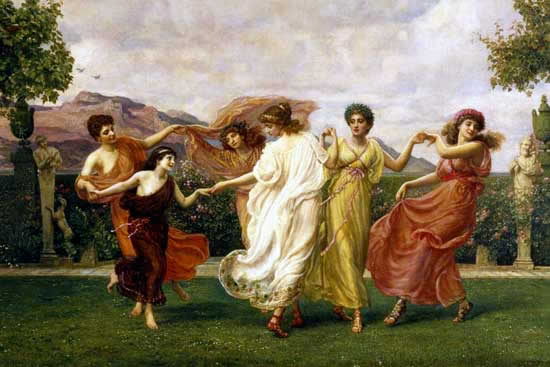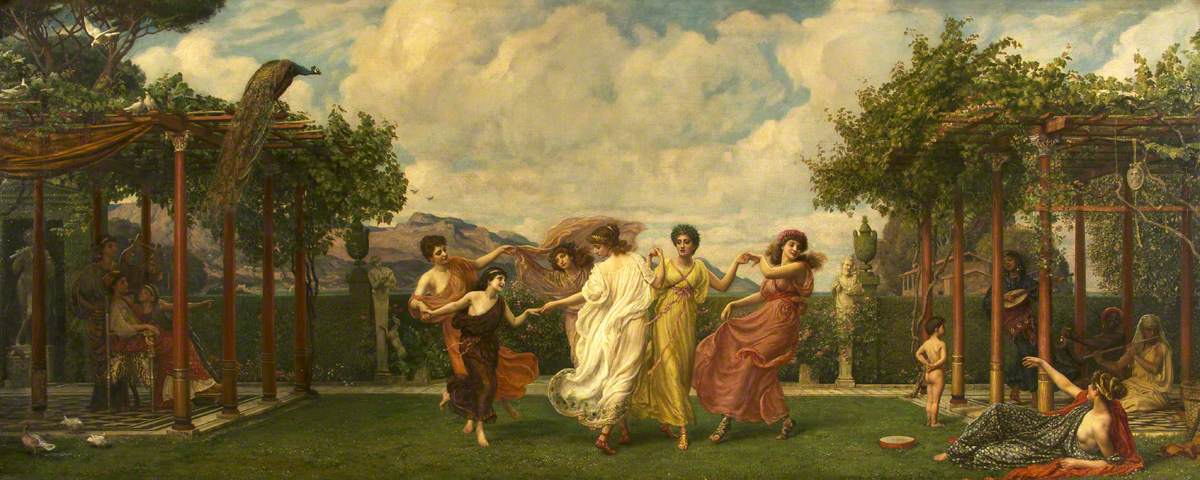
The changing of the seasons has fascinated mankind–almost forever. We can gauge the questions on people’s minds by the stories they tell, and people have been telling stories about the seasons for at east thousands of years.

The Horae [Detail] – Painted by Edward John Poynter
Image Credit: Wikimedia
The ancient Greeks were so very fascinated by the Seasons that they found a place for them in their cosmonogy. Poynter, Edward John; Horae Serenae; Bristol Museums, Galleries & Archives; http://www.artuk.org/artworks/horae-serenae-188974
Poynter, Edward John; Horae Serenae; Bristol Museums, Galleries & Archives; http://www.artuk.org/artworks/horae-serenae-188974
Horae Serenae by Edward John Poynter – Painted in 1896
In Ancient Greek Mythology, the Horae are the Seasons.
The Horae or the Hours suggest something important about the Seasons in Ancient Greek Mythology. They change.
The word “Horae” is a derivative of the English word “Hours” — in a sense, they marked the changes of the hours and thus, collectively, the seasons.
Other Greek goddesses are connected to the changes of the seasons:
Demeter was the goddess of agriculture and her daughter Persephone was the goddess of spring. In an effort to unerstand and explain why nature radically changed during fall and winter, the Ancient Greeks created a Myth. The Myth of Persephone says that Hades, the god of the dark underworld, snatched Persephone and carried her to his lair of darkness. But because of her mother’s pleas to Zeus, Persephone was released for intermittent periods of time. The time during which Persephone was relased from darkness was spring, but her fate was that of returning to the dark every winter.
“In the Greek myth of Persephone, Zeus orders Hades to release Persephone from the underworld after her mother, Demeter, causes a famine to protest her daughter’s absence. Demeter is grief-stricken over the loss of her daughter and withholds crops from growing. Zeus sends Hermes to convince Hades to release Persephone, but Hades tricks her into eating a pomegranate seed before letting her go. Because she ate food from the underworld, Persephone can’t be fully freed and must spend part of the year with Hades. A compromise is reached where Persephone spends four months with Hades as his queen, one for each pomegranate seed she ate, and the other eight months with her mother.” Google ai
The myth of Pesephone tells us several things about the people who created the story. Primarily, it tells us that for thousands of years, people have been aware of–and no doubt, perplexed by the changing of the seasons. But ancient interest in the seasons did not stop at the creation of stories. Several ancient civilizations extensively researched the seasons and their astrologers noted changes in the stars and planets simultaneous with the changing of the seasons.
For thousands of years, wise men have marked the times when the sun lines up in specific ways, and from that study, days were designated as seasonal equinoxes and solstices.

Autumn Equinox falls on about September 21 or 22 each year, That is one of two times each year that the sun shines directly on the equator. The same thing happens in March. The Autumn Equinox Marks the Beginning of Fall. The Spring Euinox [March] Marks the Beggining of Spring. The Seasonal Solstices mark the first days of summer and winter. The Equinoxes and Solstices help us mark the seasons of the year.
Allow me to add that people today are still fascinated by the seasons, and they continue to tell stories about them:
Discover more from Jacki Kellum
Subscribe to get the latest posts sent to your email.